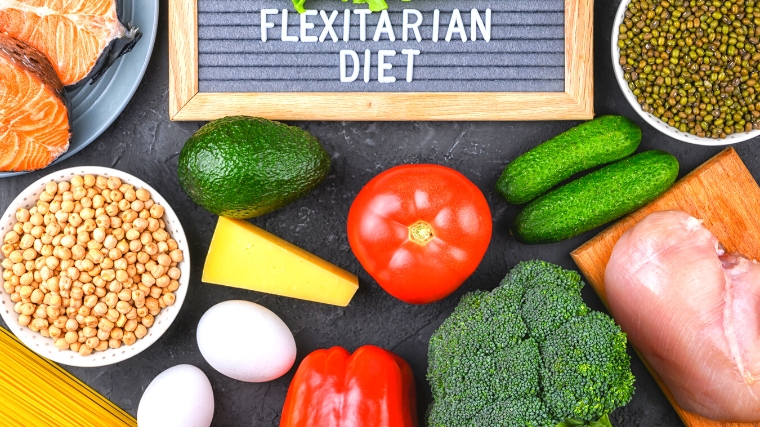All diets, in one way or another, are designed around managing what foods you eat in what quantities. Whether you cut carbs with the ketogenic diet or go all-in on meat with the carnivore diet, the overarching idea is the same — certain foods are “good,” while others are “bad.”
True to its name, flexible dieting rejects this premise. In fact, it’s not even a diet at all, at least not in the literal sense. In recent years, flexible dieting has picked up a lot of momentum among bodybuilders and recreational gymgoers alike.

If you’re wondering what it is, how (and whether or not) it works, look no further. Here’s everything you need to know about flexible dieting, and how to determine whether or not it’s right for you.
What Is Flexible Dieting?
The core idea behind flexible dieting is, well, flexibility. Specifically, flexibility regarding your food source selection — the foods you choose to eat to fuel your health and performance.
Where many diets emphasize food source restriction (think of the paleo diet prohibiting manufactured food products or anything not deemed “natural”), flexible dieting is more of a broad dietary paradigm.

Think of flexible dieting as a general lifestyle approach to food source selection; flexible dieters don’t strictly categorize any food as inherently good or bad. Just about any food is fair game for the flexible dieter, as long as the quantity and nutritional quality of the food can gel with their goals.
Flexible Dieting vs. “If It Fits Your Macros” (IIFYM)
The famous (or infamous, depending on who you ask) if-it-fits-your-macros protocol, or IIFYM, exists within the paradigm of flexible dieting. It’s a very similar, but not identical, approach to selecting your food sources.
IIFYM is strictly about the quantitative nutritional value of a food source within the larger context of a diet. Practitioners may include junk food, snacks, sweets, or anything otherwise considered “unhealthy” as long as the macronutrient and calorie content aligns with their weight-related goals.
So, you can think of IIFYM as a no-holds-barred dietary philosophy centered around the quantitative value of food sources. Flexible dieters tend to be more concerned with the foods themselves, broadly speaking, but differentiating the two is arguably semantic in some contexts.
On Intuitive Eating
Intuitive eating is another dietary practice that exists in the realm of, but is not attached to, flexible dieting. Intuitive eaters focus on conscious sensory inputs to motivate their food consumption, such as learning to separate legitimate hunger signals from peripheral sensations like boredom or anxiety. (1)
However, research indicates that intuitive eating practices don’t significantly influence total caloric intake or the quality of food source selection. (1) So, you can certainly be a flexible dieter who also eats intuitively. However, coupling both practices together may not work as well if you have specific weight-management-related goals.
Benefits of Flexible Dieting
Any dietary regimen, whether you’re adhering to a pre-written meal plan or a general food philosophy, needs to be both practically applicable and well-supported by a comprehensive body of scientific evidence. Luckily, flexible dieting checks both boxes.
(Possibly) More Muscle Growth
A fluid approach to food source selection doesn’t necessarily mean you’ll bulk up faster or work harder in the weight room. That said, there’s some limited evidence that has shown flexible dieters have more favorable hypertrophy-related outcomes than rigid “clean eaters” — athletes who consume a limited variety of perceived physique-friendly foods (think chicken, brown rice, sweet potatoes, oats, and the like). (2)
It’s worth noting that this data displayed equally efficacious outcomes for fat loss, and that the researchers hesitate to draw causative conclusions between flexible dieting specifically and muscle gain.
More Robust Micronutrient Consumption
Some literature indicates that “clean eating” may not be as productive for your health or performance as you might think. Certain studies have shown that while flexible dieters and rigid clean eating-bodybuilders come out of a diet with comparable weight adjustments (whether they’re packing on mass or shredding down), the athletes with a wider range of permissible foods had better micronutrient intake profiles. (3)
Limiting your food source selection to a small assortment of individual foods — even if they’re each quite nutritionally dense — may mean you’re omitting adequate consumption of certain vitamins and minerals.
More Dietary Sustainability
No matter your “why” for conducting some level of oversight on your dietary habits, whatever practices you’re, well, practicing, need to be sustainable long-term. You can’t melt fat off your body in a week’s time, nor can you encase yourself in muscle by upping your protein intake for a few days.
In that regard, flexible diets and meal plans handily beat out rigid or limited diets. For bodybuilders or physique-minded gymgoers in particular, studies show that so-called “rigid dietary control” can promote binge eating or other detrimental psychological effects:
“Success as a bodybuilder depends on, at least in part, the ability to successfully restrain eating … in that regard, a flexible approach to dieting is considered to be more adaptive and sustainable than a rigid approach.” (4)

Adjacent behaviors like portion control, mindful eating, weight tracking, and reasonable indulgence in high-calorie foods are also correlated with successful diet outcomes for bodybuilders. This may be due to the fact that flexible dieters or IIFYM practitioners often adhere to the principles behind caloric control and energy balance. (5)
Note, though, that even well-crafted studies do not perform all of the necessary legwork to explain an individual’s unique and complex relationship with food. If you’re worried about your eating habits and how they relate to your health, your best bet is to consult with a qualified medical professional.
Better Weight Management
Flexible dietary restraint — which is how flexible dieting is often described in weight loss literature — tends to lead to better weight management outcomes than rigid or restrictive food sourcing. (6)
A large portion of the literature attributes that success to positive cognitive behaviors — if you can view foods outside of a good-or-bad binary, you may be more likely to indulge in your favorite sweet or savory foods in reasonable quantities without derailing your overall weight management goals.
A Wider Selection of Foods
Perhaps the biggest benefit of adopting a flexible dietary plan is also the most obvious one; you’re able to eat a larger variety of foods than someone who follows a more prohibitory plan. Not only does this open up access to more micronutrient sources, it simply lets you incorporate more foods that you find personally satisfying to eat.
This can help break up the monotony of a long, multi-month dieting phase, especially if you’re trying to drop some weight on the scale. It’s easy for eating to become a chore if you’re shackled to the same seven or eight foods: Flexible dieting allows you to take a more active and creative role in the curation of your meals.
Drawbacks of Flexible Dieting
Make no mistake, flexible dieting isn’t the end-all, be-all of nutritional science. Despite having a large body of sound scientific support singing its praises, a flexible approach to consumption isn’t necessarily right for every individual in every context.
More Time in the Kitchen
Opening the door to a wider variety of foods can be fun, certainly, but it also amounts to more time spent poring over your nutritional log or journal if you choose to count your macronutrients. Working with new foods can also mean some trial-and-error in the kitchen if you’re not an experienced cook.

If you’re an athlete or dieter who values expedience and efficiency above all else, it may be better to stick to a more restrictive food-sourcing plan, if only for the sake of logistics. Purchasing and preparing a small assortment of foods on a regular basis will generally save you time in the kitchen overall.
May Be More Expensive
Rigid dietary restraint isn’t necessarily a pragmatic, cost-effective behavior, but it does tend to align with the stereotypical “bodybuilder’s diet.” Ground beef, oats, rice, eggs, and frozen veggies are typically quite cost-effective.
Expanding your palate is fun, but incorporating more exotic food options can ratchet up your grocery bill — nevermind the potential cost of kitchenware, spices, and niche ingredients as well. If you’re financially constrained, the freedom of flexible dieting may not be worth cashing in on.
A Potentially Slippery Slope
Some people do better with dietary freedom than others. Restriction tends to have a negative connotation, but rigid self-control can also serve as a helpful guardrail for those who find themselves regularly tempted to indulge in certain foods more than they’d like.
If you have a serious sweet tooth — as in, you’re liable to crush an entire tub of Ben & Jerry’s if left to your own devices — rigid dietary restraint may be a more appropriate philosophy for you. This approach can work particularly well if you’re trying to adjust your weight to meet a specific time-sensitive deadline, such as a powerlifting or weightlifting meet with defined bodyweight caps.
Who Should Try Flexible Dieting
The nature of flexible dieting itself makes it appropriate for just about anyone. Still, you may fall into one of the following camps and are poised to benefit a great deal from the protocol.
First-Time Dieters
Changing your health habits is a daunting prospect. Adjusting what you eat on a daily basis can be especially intimidating, particularly if you’re taking your first steps on your wellness journey. It’s quite common for newcomers to (falsely) believe they have to give up all their favorite foods in favor of bland, unexciting “fit foods.”
While you should expect to make some prominent changes to what you fuel your body with, flexible dieting prevents you from having to throw the baby out with the bathwater altogether.
Whether you want to shed some fat, bulk up, or just improve the quality of your day-to-day nutrition, you can begin by making a few smart substitutions — think plain oatmeal for breakfast instead of a sugary cereal — and leave your favorite foods in your diet for the time being.
Recreational Lifters
If you hit the gym but don’t have competitive aspirations, you aren’t hamstrung by the constraints of sticking to a certain weight class which may impact or limit your food choices. Flexible dieting practices fit nicely into the demands of a hectic work schedule and also mesh well with a variety of different or evolving fitness goals.
Bodybuilders
Proper nutrition is absolute integral to the success of any bodybuilder, whether they’re hitting their first arm workout or are trying to qualify for the Mr. Olympia competition. That said, many physique athletes who adhere too tightly to a limited assortment of “physique foods” may be missing out on certain essential nutrients. (3)
In the Off Season
Having months of time before your next stage appearance (or beach season, if you train more casually) is a great time to loosen the reins on your food source selection.

You can incorporate more exotic and flavorful options without worry, and even add in some higher-calorie options that may not fit into your macros if you’re running a restrictive caloric deficit.
During Contest Prep
Your best bet for making it to the bodybuilding stage is to recruit the supervision and mentorship of a qualified physique coach. This individual will often guide you through the rigors of a contest dieting phase and may severely restrict your dietary options for several months.
While you should almost certainly defer to your coach’s expertise, don’t be afraid to inquire about the inclusion of certain foods in reasonable quantities.
Your Takeaways
Flexible dieting is a dietary philosophy that encourages a wide variety of food sources. Those who practice flexible dieting don’t view any individual food as appropriate or inappropriate for their nutritional needs.
- Flexible dieting is very similar to the practice of “if it fits your macros” (IIFYM) eating, but is concerned more with enabling access to nearly any individual food rather than making all foods fit into certain nutrient budgets.
- Research demonstrates that so-called flexible dietary restraint is more effective for dietary adherence than rigid restraint.
- Flexible dieting behaviors are compatible with a wide variety of health or performance-related goals.
Get Flexible
Your relationship with food is deeply personal. While following a strict, food-specific diet can be great for taking the guesswork out of your nutrition, a more flexible approach may end up being better for you in the long run.
Flexible dieting, intuitive eating, and IIFYM all exist within the same paradigm in which foods aren’t blindly categorized as bad or good — their use or potential harm depends entirely on context. There’s a wide world of tasty, healthful foods out there. You can sample just about any of them and still reach your goals with room to spare.
References
1. Grider, H. S., Douglas, S. M., & Raynor, H. A. (2021). The Influence of Mindful Eating and/or Intuitive Eating Approaches on Dietary Intake: A Systematic Review. Journal of the Academy of Nutrition and Dietetics, 121(4), 709–727.e1.
2. Conlin, L. A., Aguilar, D. T., Rogers, G. E., & Campbell, B. I. (2021). Flexible vs. rigid dieting in resistance-trained individuals seeking to optimize their physiques: A randomized controlled trial. Journal of the International Society of Sports Nutrition, 18(1), 52.
3. Ismaeel, A., Weems, S., & Willoughby, D. S. (2018). A Comparison of the Nutrient Intakes of Macronutrient-Based Dieting and Strict Dieting Bodybuilders. International journal of sport nutrition and exercise metabolism, 28(5), 502–508.
4. Helms, E. R., Prnjak, K., & Linardon, J. (2019). Towards a Sustainable Nutrition Paradigm in Physique Sport: A Narrative Review. Sports (Basel, Switzerland), 7(7), 172.
5. Mitchell, L., Hackett, D., Gifford, J., Estermann, F., & O’Connor, H. (2017). Do Bodybuilders Use Evidence-Based Nutrition Strategies to Manipulate Physique?. Sports (Basel, Switzerland), 5(4), 76.
6. Westenhoefer, J., Engel, D., Holst, C., Lorenz, J., Peacock, M., Stubbs, J., Whybrow, S., & Raats, M. (2013). Cognitive and weight-related correlates of flexible and rigid restrained eating behaviour. Eating behaviors, 14(1), 69–72.
Featured Image: Fedorova Ekaterina-84 / Shutterstock